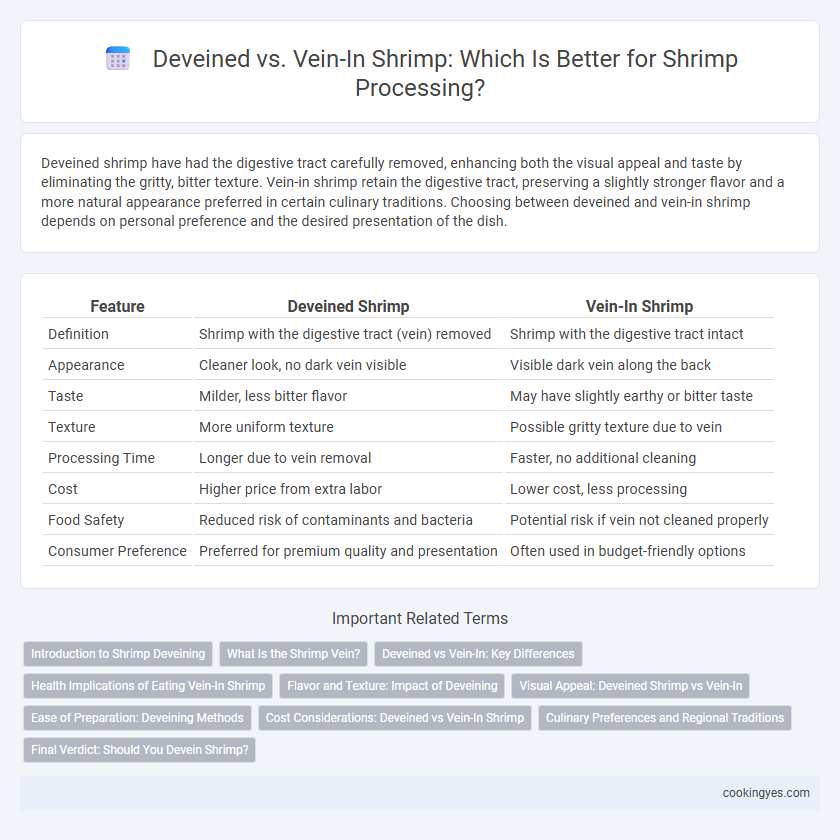Deveined shrimp have had the digestive tract carefully removed, enhancing both the visual appeal and taste by eliminating the gritty, bitter texture. Vein-in shrimp retain the digestive tract, preserving a slightly stronger flavor and a more natural appearance preferred in certain culinary traditions. Choosing between deveined and vein-in shrimp depends on personal preference and the desired presentation of the dish.
Table of Comparison
| Feature | Deveined Shrimp | Vein-In Shrimp |
|---|---|---|
| Definition | Shrimp with the digestive tract (vein) removed | Shrimp with the digestive tract intact |
| Appearance | Cleaner look, no dark vein visible | Visible dark vein along the back |
| Taste | Milder, less bitter flavor | May have slightly earthy or bitter taste |
| Texture | More uniform texture | Possible gritty texture due to vein |
| Processing Time | Longer due to vein removal | Faster, no additional cleaning |
| Cost | Higher price from extra labor | Lower cost, less processing |
| Food Safety | Reduced risk of contaminants and bacteria | Potential risk if vein not cleaned properly |
| Consumer Preference | Preferred for premium quality and presentation | Often used in budget-friendly options |
Introduction to Shrimp Deveining
Deveining shrimp involves removing the dark digestive tract, which can impact flavor and texture by reducing grit and bitterness. Vein-in shrimp retains this intestinal tract, often preferred for presentation or traditional recipes despite a slightly stronger taste. Proper shrimp deveining enhances consumer appeal and ensures a cleaner eating experience, aligning with quality seafood processing standards.
What Is the Shrimp Vein?
The shrimp vein, technically called the digestive tract, is a dark, thread-like tube running along the back of the shrimp, containing waste and grit that can affect taste and texture. Deveining is the process of removing this vein to improve the shrimp's appearance and reduce any potential bitterness or sandiness. While vein-in shrimp retain the digestive tract, some consumers prefer deveined shrimp for a cleaner eating experience and presentation.
Deveined vs Vein-In: Key Differences
Deveined shrimp have their digestive tract removed, resulting in a cleaner taste and improved texture, while vein-in shrimp retain the dark vein, which some consumers prefer for presentation or minimal processing. Deveining enhances food safety by reducing potential contaminants and improving visual appeal, but it requires extra labor and processing time. Vein-in shrimp maintain more natural flavor and nutrients, favored in certain culinary traditions despite the slightly bitter taste the vein might impart.
Health Implications of Eating Vein-In Shrimp
Eating vein-in shrimp poses potential health risks due to the presence of the digestive tract, which may contain sand, grit, and contaminants such as bacteria and pathogens. Consuming shrimp without deveining increases exposure to harmful microorganisms like Vibrio bacteria, which can cause foodborne illnesses. Proper deveining significantly reduces the risk of ingesting these contaminants, promoting safer consumption and better food hygiene.
Flavor and Texture: Impact of Deveining
Deveining shrimp removes the dark intestinal tract, which can impart a slightly gritty texture and a bitter, earthy flavor if left intact; vein-in shrimp often retain a more natural appearance but may have a subtle bitterness. The removal of the vein results in a cleaner, milder taste and a smoother texture, enhancing the overall eating experience. Shrimp processing that includes deveining is preferred in culinary applications where a delicate flavor and refined texture are essential.
Visual Appeal: Deveined Shrimp vs Vein-In
Deveined shrimp offer a cleaner, more visually appealing presentation by removing the dark digestive tract, which can appear unappetizing to consumers. Vein-in shrimp retain this vein, often visible as a dark line, detracting from the shrimp's aesthetic quality despite being safe to eat. Chefs and seafood processors prefer deveined shrimp to enhance the overall look and marketability of dishes.
Ease of Preparation: Deveining Methods
Deveining shrimp involves removing the dark digestive tract, which improves both texture and taste. Popular deveining methods include using a paring knife to carefully slit the back or employing specialized tools like shrimp deveiners for efficiency. Though vein-in shrimp require less initial preparation, deveined shrimp save time during cooking and presentation, making the extra prep worthwhile for many chefs.
Cost Considerations: Deveined vs Vein-In Shrimp
Deveined shrimp processing involves removing the dark digestive tract, increasing labor and processing costs compared to vein-in shrimp, which retain the vein. Vein-in shrimp are generally less expensive due to reduced handling, but some consumers may perceive deveined shrimp as higher quality, justifying a premium price. Cost considerations balance labor intensity with market demand, impacting overall pricing and profit margins in shrimp processing.
Culinary Preferences and Regional Traditions
Deveined shrimp are preferred in Western culinary traditions due to their cleaner appearance and milder flavor, enhancing presentation and texture in fine dining dishes. In contrast, vein-in shrimp remain popular in Asian and Mediterranean cuisines where the vein is considered natural and can add a slight umami taste, reflecting regional processing methods. These culinary preferences influence shrimp processing choices, aligning with cultural expectations and traditional cooking practices in different regions.
Final Verdict: Should You Devein Shrimp?
Deveining shrimp removes the digestive tract, improving texture and reducing potential grit or bitterness, which enhances overall taste and presentation. Vein-in shrimp retain their natural appearance and may offer a slightly more robust flavor, preferred in some culinary styles. For optimal eating experience and food safety, deveining is recommended, especially for larger shrimp or when serving guests.
Deveined vs vein-in for shrimp processing Infographic

 cookingyes.com
cookingyes.com